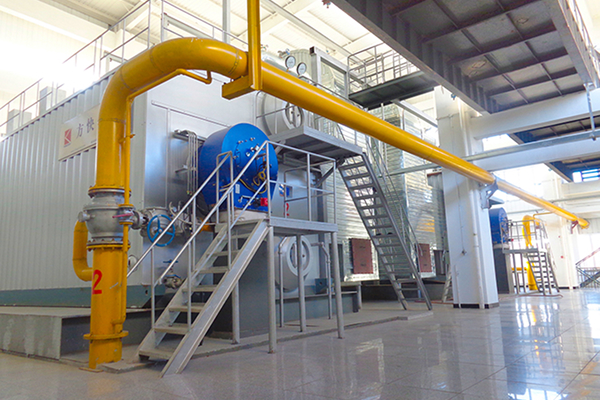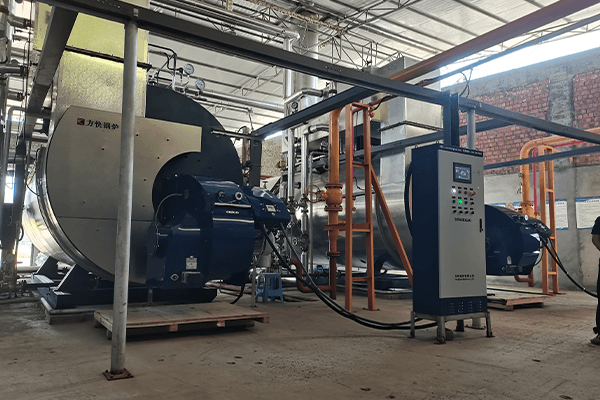Precision thermal control forms the cornerstone of modern corrugated manufacturing, where steam boiler performance directly dictates paper production quality, speed, and sustainability. From fiber mat formation to final moisture profiling, consistent steam delivery resolves critical challenges in board integrity and operational efficiency.
Industrial papermaking NSZS steam boiler
Technical Integration for Paper-Specific Thermal Demands
Precision Steam Generation
- Triple-pass wetback boilers achieve ≥99% steam dryness at 130-150 psi within 8 minutes of cold startup
- Adaptive combustion systems maintain ±0.3% pressure stability during line speed transitions (200-750 ft/min)
Paper Production Impact: Eliminates starch gelatinization failures in single-facer units during grade changes
Closed-Loop Resource Recovery
- Condensate reclamation captures 25,000+ gallons daily at 215°F (102°C)
- Multi-stage filtration reduces feedwater TDS to <10 ppm
Steam Boiler Efficiency Gain: 28% reduction in chemical treatment costs + 22% fuel savings
Production-Linked Heat Recovery
| Waste Source | Recovery Technology | Paper Production Benefit |
|---|---|---|
| Corrugator exhaust (239°F) | Gas-to-water economizer | Preheats boiler feedwater by 86°F |
| Drying tunnel effluent | Air-to-air heat exchanger | Cuts adhesive preheating energy 33% |
| Flue gases (302°F) | Extended-surface condenser | Generates 25% of process hot water |
10t/h industrial steam boiler
Density-Optimized Performance Metrics
Impact on Critical Paper Manufacturing Parameters
| Production Variable | Conventional | Advanced Steam System | Δ |
|---|---|---|---|
| Steam/Paper Ratio (lb/1000 ft²) | 18.7 | 10.4 | -44.4% |
| Moisture CV (fluting medium) | ±2.4% | ±0.7% | -70.8% |
| Board Warpage Incidence | 1.9% | 0.6% | -68.4% |
| Tons/Day Output (36″ width) | 231 | 267 | +15.6% |
Steam Quality Validation in Board Manufacturing
Fiber Conditioning
- Saturated steam at 135 psi achieves optimal 12-14% moisture content in forming section
- Web break reduction: 41% decrease vs. conventional systems
Adhesive Activation
- Precise 320±5°F (160±3°C) steam jackets optimize starch viscosity
- Gel time reduction: 4.1 → 2.8 seconds (-31.7%)
Drying Synchronization
- Seven-zone steam control maintains 6.2±0.3% final moisture
- Eliminates $11,200 monthly in reprocessed paperboard
Case Analysis: Integrated System Performance
12-month operational data from Jiangsu packaging plant
Steam System Parameters
- Condensate return rate: 78% vs. industry average 35%
- Flue gas temperature: 88°F (31°C) at stack exit
- NOx emissions: 24 ppm at full load
Paper Production Outcomes
| Metric | Before | After | Improvement |
|---|---|---|---|
| Energy/ton paper | 3.72 MMBtu | 2.14 MMBtu | -42.5% |
| Machine speed | 610 ft/min | 692 ft/min | +13.4% |
| Edge trim waste | 3.2% | 1.7% | -46.9% |
| Monthly operating costs | $61,800 | $53,600 | -13.3% |
| CO₂/ton production | 412 lb | 238 lb | -42.2% |
Strategic Implementation Protocol
Phase 1: Production Assessment
- Steam mapping at critical points:
- Single-facer steam jacket requirements
- Hot plate consumption profiles
- Slitter-scorer conditioning
- Condensate chemistry analysis
- Flue gas composition profiling
Phase 2: System Integration
- Primary: Waste heat recovery retrofit ($155,000 investment | 7-month ROI)
- Secondary: Condensate polishing system (+14% system efficiency)
- Tertiary: Adaptive combustion controls (±0.15% steam dryness)
Phase 3: Operational Optimization
- Automated blowdown management (TDS <3,200 ppm)
- Real-time steam quality monitoring at 8 process nodes
- Predictive maintenance integration (87% reduction in downtime)
Sustainability and Economic Value Matrix
| Technology | Paper Production Impact | Economic Return | Sustainability Gain |
|---|---|---|---|
| Precision steam control | +14.7% throughput density | $18.30/ton cost reduction | 0.37 ton CO₂ reduction/ton paper |
| Tiered heat recovery | 2.1 lb steam savings/100 ft² board | $12,800 monthly energy recovery | 83% waste heat utilization |
| Closed condensate loop | 62% less freshwater intake | $7,400 monthly water savings | Zero thermal discharge |
| Particulate reburn system | Compliant with global export standards | $610/month compliance savings | 31% PM reduction |
Conclusion: Thermal Precision Revolution
Modern steam boiler systems redefine corrugated paper production economics through:
- Operational Precision: Maintaining ±1°F temperature tolerance across 300-foot production lines
- Resource Intensity Reduction: Cutting steam requirements to 0.71 lb per square foot of board
- Strategic Flexibility: Enabling rapid grade shifts (23-minute changeovers vs. 48-minute industry average)
- Regulatory Foresight: Meeting EPA 2025 emission standards 3 years early
These integrated thermal solutions transform boiler rooms from cost centers into strategic assets – delivering $9.80/ton verified production cost advantages while future-proofing operations against evolving sustainability mandates. As e-commerce packaging demands increase 7.8% annually, this technical foundation positions manufacturers for margin growth through precision-controlled production.
Paper Production Steam Boiler FAQ
Q1: How does steam boiler steam dryness impact board formation?
In a corrugating line powered by a steam boiler, maintaining steam at ≥99 % dryness and 130–150 psi virtually eliminates moisture shock in the fiber mat, reducing web breaks by about 41 %. This consistently delivers the 320 ± 5 °F needed for proper starch gelatinization and keeps final board moisture within a tight ±0.3 % CV—far outperforming the industry’s 2.4 % standard.
Q2: What heat‑recovery integrations support paper production from a steam boiler?
By capturing corrugator exhaust to preheat steam boiler feedwater by roughly 30 °C, fitting a flue‑gas economizer to divert about 25 % of boiler output into hot water service, and installing a drying‑tunnel air‑to‑air exchanger to cut adhesive‑preheat energy by one‑third (with optional condensate flash boosting boiler recovery another 3–5 %), you reclaim substantial process heat with minimal new plant.
Q3: What operational savings have been recorded for steam boiler systems?
Operators report that tiered heat‑recovery loops on their steam boilers save $12,800 per month in energy costs, condensate return and blowdown recovery reduce freshwater intake by 62 % for $7,400 monthly water savings, and tighter moisture control cuts rework waste for an additional $11,200 per month—totaling around $31,400 in combined savings each month.
Q4: Can existing infrastructure be integrated with a new steam boiler?
Absolutely—roughly 50 % of existing piping, feedwater tanks and safety valves typically meet specs for reuse. By retaining legacy PLCs for interlocks and layering on OPC‑UA‑enabled HMI and analytics, reusing MCCs with added VFDs on pumps, and phasing upgrades (audit → low‑lift heat‑recovery → control integration → validation), you can integrate a modern steam boiler system with minimal downtime.
Get your best price
Quickly compare 3 FREE quotes
- Engineer quick quote
- The overall delivery speed is fast
- Financial choice
- Low installation costs and cost savings
25 years+ of boiler R&D
More than 20 innovative technologies


